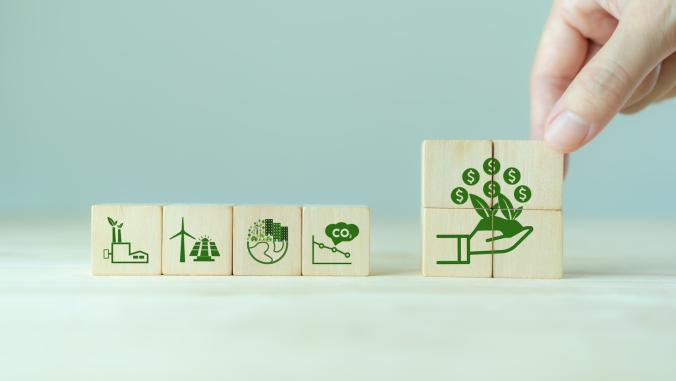‘Super pollutants’ such as methane, HFCs and black carbon were a hot topic at GCAS
Acting quickly to reduce relatively short-lived yet potent gases could have a big impact on human health and slow global warming.

The Pisces Foundation created the "Super Swift" super hero to draw attention to super pollutants such as HFCs from air conditioners and refrigerators, methane from oil and gas production and black carbon spewed from diesel trucks, buses and ships.
Prepare to hear a growing chorus of climate activists — from executives and environmentalists to policymakers and politicians — call for swifter action on reducing so-called "Super pollutants." Apparently, we don’t have much of a choice if we’re to realize the temperature-tempering dreams of the Paris Agreement, according to science.
"Mitigation of super pollutants is the only way to keep it below 2 degrees [Celsius] by 2050, while we are waiting for the CO2 measures to kick in," said Veerabhadran Ramanathan, distinguished professor of atmospheric and climate sciences at the Scripps Institute of Oceanography, at the University of California, San Diego.
His remarks came during Super Pollutant Day, one of the affiliate events during last week’s Global Climate Action Summit. The program was developed by the Climate & Clean Air Coalition, the Pisces Foundation and ClimateWorks Foundation.
The projected impact of these actions: preventing a half-degree Celisus of the warming trend, averting up to 2.4 million premature deaths and saving up to 50 million metric tons of crops each year, said Inia Seruiratu, minister for agriculture, rural and maritime development, and nation disaster management for the island nation of Fiji. This is especially important for vulnerable communities, he said.
Super-pollutant greenhouse gases such as methane, black carbon (aka soot), nitrous oxide, chlorofluorocarbons (CFCs) and hydrofluorocarbons (HFCs) don't have a long lifespan in the atmosphere (measured in days and decades rather than the centuries that carbon dioxide could hang around) but data suggests they have an outsize negative impact on the global warming trend during their aerial lifespan.
Indeed, some figures suggest that, collectively speaking, super pollutants may be contributing as much as 50 percent to the current warming trends of the planet. Without more aggressive reduction or phase-out measures, there’s a strong possibility that temperatures could rise 1.5 degrees Celsius before 2030 (barely a decade away) with catastrophic implications for human health, according to data cited during the event.
"We are right on the edge of a different climate that we might not be able to recover from," said Durwood Zaelke, president and founder of the Institute for Governance and Sustainable Development, speaking during the event.We are right on the edge of a different climate that we might not be able to recover from.
None of this is really new news. And there is reason to be hopeful.
As just one example, the Kigali Amendment to the Montreal Protocol — the framework credited with reversing depletion of the earth’s ozone layer — was adopted in December 2016 to phase down production of HFCs. The Natural Resources Defense Council (NRDC) is working with a trade group representing some of the biggest makers of climate control technologies, the Air-Conditioning, Heating and Refrigeration Institute (AHRI), to help manufacturers comply with the phase-out schedule. That group stepped forward Friday to declare they will support the accelerated replacement of HFCs — at least in home air-conditioning systems — with safer substances by 2023. And they sent a letter to the California Air Resources Board in support of the state's new rules for a phase down, which zeroes in on building chillers.
"We believe that these measures balance environmental benefit with minimizing the cost impact on consumers, all while providing adequate time for manufacturers, distributors and contractors to prepare for a safe and efficient transition to lower [global warming potential] technologies," they noted in the letter. Signatories include Carrier, Dalkin Applied Americas, Goodman Manufacturing, Lennox International, Nortek Global, Trane, the Chemours Co. and Honeywell International.
Indeed, with the Trump administration basically ceding national leadership on a wide range of environmental issues — and actively working to reverse or eliminate longstanding policies on pollution, toxic chemicals and clean water — a chorus of cities, climate activists, states and industries is picking up the mantle on the super-pollutant issue.
Virginia, for example, disclosed last week that it’s working on regulations to limit leaks of methane from natural gas pipelines, even as the Trump administration signaled it would step back from enforcing rules established under President Barack Obama. Maryland made a new vow to phase out hydrofluorocarbons (HFCs), commonly found in refrigerants, as did Connecticut. (New York and California previously declared their intention to do so.)
The imperative of acting on the HFC issue is readily apparent and fraught with irony: as temperatures increase, the demand for massive building chillers and other air-conditioning technologies likewise will rise.
"Cooling is central to everything," observed Rachel Kyte, CEO and special representative of the United Nations Secretary-General for Sustainability Energy for All. That goes for humans, food and life-saving medicines. "We must think totally differently about this."
Nanette Lockwood, global director of policy and advocacy for Ingersoll Rand, who spoke during the event last week, said a large part of the cooling technology industry is indeed focusing on "pragmatic, predictable and cost-effective measures" to address HFCs. "We support state regulations that provide uniformity," she said, hinting about news in the near future.
The trouble with methane
The impact of methane is also generating headlines because of the rapid pace at which utilities and energy developers are retiring coal-fired power plants across the United States and adding other generating technologies to the electricity grid, particularly natural gas.
EDF has estimated that methane is 84 times more potent than CO2 in its first two decades in the atmosphere. That’s concerning because the infrastructure for getting natural gas to homes, factories or commercial buildings is notoriously leaky — from drill site all the way to your neighborhood.
Few, if any, incentive programs are in place to encourage solutions to that problem, according to Bruce Nilles, a recently appointed Rocky Mountain Institute senior fellow and previously a big force behind the Sierra Club's highly successful Beyond Coal campaign. (He's been working on that effort for the past 15 years. Currently, more than half of the United States' 530-plant coal fleet is slated for retirement.)
"Natural gas is used in buildings, electricity production and a whole suite of industrial uses," Nilles told me when we chatted about coal economics earlier this month. "Just the carbon emissions alone, today, from all that gas exceed the carbon emissions from coal — not in the electric sector, but across all sectors. ... These other sectors — outside of electricity, where emissions have been coming down — have not been coming down. Buildings, transport, industry are either flat or increasing. A lot of that is expanded use of gas."We've got to focus on developing a systematic approach to this problem so that it's not just an appliance here, an appliance there.
In California, for example, the percentage of natural gas needed for thermal and industrial loads exceeds what's used to generate power in the state. "We've got to focus on developing a systematic approach to this problem so that it's not just an appliance here, an appliance there," Nilles noted. "We need whole-building degasification, and there's 70 million buildings in the U.S."
This is the focus of Nilles’s research through an award from the Climate Breakthrough Project, an initiative funded by the David and Lucile Packard Foundation, Oak Foundation and Good Energies Foundation.
Some oil and gas companies have taken a proactive stance in addressing the methane issues: the Oil and Gas Climate Initiative, which represents 10 major oil and gas operators including BP, Total and Shell, has committed to establishing reduction targets by the end of this year; and another group has aligned with EDF with similar intent. Companies such as BP, ExxonMobil and Statoil already have adopted individual policies.
"The momentum around methane has grown significantly as investor awareness of the issue grows, but in terms of the climate and business impacts," said Sean Wright, senior manager with EDF, who attended GCAS last week to meet with investor groups concerned with improved disclosure of climate risks. "It’s been heartening to see the industry start taking steps" to address the problem.





